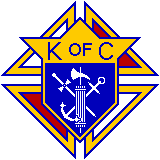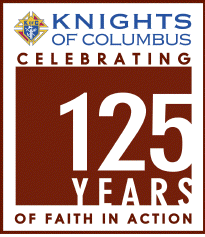|
Our Order The
Knights of Columbus is a world-wide Catholic
fraternal organization of over 1.7 million
members. In 2007, the Knights raise a record
$144.9 million for various charities while
promoting the unity of Catholic men and their
families. Knights strive to practice those
values in which they believe: faith, hope,
charity, and patriotism. Ours is an organization
which seeks to promote the forces of life and
hope.
Our council offers a myriad of great opportunities for male Catholic men. Our organization is perfect for honing your leadership skills, helping out people in need, improving you faith, and developing relationships that will last a lifetime. Not only do we offer you a chance to reach out and make a difference in this world, but you will be able to enjoy the fellowship of the other brothers in our council. In our brotherhood you will be able to meet men from all walks of life. Many are already successful in their careers and could offer valuable advice to you. There are plenty of opportunities for fellowship and growth. Visit the Supreme Council website at www.kofc.org. |
|
The
Patriotic Degree
 her degree open to
members of the Knights of Columbus is that of the Fourth
or Patriotic
Degree. On February 22, 1900,
the first exemplification of that degree was held in New York City. The
ritual added patriotism to the three original principles
of the Order: charity, unity, and
fraternity. Any Third Degree
member in good standing, one year after the anniversary
of his First Degree, is eligible for membership in the
Fourth Degree.
her degree open to
members of the Knights of Columbus is that of the Fourth
or Patriotic
Degree. On February 22, 1900,
the first exemplification of that degree was held in New York City. The
ritual added patriotism to the three original principles
of the Order: charity, unity, and
fraternity. Any Third Degree
member in good standing, one year after the anniversary
of his First Degree, is eligible for membership in the
Fourth Degree.
The primary purpose of the Fourth
Degree is to foster the spirit of patriotism by promoting responsible citizenship and a love
of and loyalty to the Knights' respective countries
through active membership in local Fourth Degree groups
called assemblies. Fourth Degree members must retain
their membership as Third Degree members in the local
council to remain in good standing.
Certain members of the Fourth Degree
serve as honor guards at civic and religious functions, an activity which has brought
worldwide recognition to the Knights of Columbus
organization.
Several members of Council 10209
are also members of the Bishop Louis J. Reicher Assembly
1099.
 The emblem of the order dates from the
Second Supreme meeting, May 12, 1883, when it was
designed by James T. Mullen, who was then Supreme
Knight.
The emblem of the order dates from the
Second Supreme meeting, May 12, 1883, when it was
designed by James T. Mullen, who was then Supreme
Knight.
A quick glance at the emblem indicates a shield mounted
upon the Cross of Malta. The shield is that associated
with a Medieval Knight. The Cross of Malta is the
representation in a traditionally artistic design of the
Cross of Christ through which all graces of redemption
were procured from mankind. This then represents
the Catholic Spirit of the Order.
Mounted on the shield are three objects, a mace standing
vertically, and crossed behind it, an anchor and a
dagger or short sword. The mace from Roman days is
symbolic of authority which must exit in any tightly
bonded and efficient operating organization.
The anchor is the mariner's symbol for Columbus, Patron
of the Order, while the short sword or dagger was the
weapon of the Knight when engaged upon an errand of
mercy. Thus, the shield expresses Catholic Knighthood in
organized merciful action and with the letters K of C
proclaims this specific form of activity.
The red, white, and blue in the background of the shield
and foreground of the Cross of Malta are the colors of
our beloved country. As such, Red is the symbol of the
stout-hearted courage, of pulsing activity, and a full
measure of devotion. Blue is the symbol of hope, of calm
tranquility under God, and of confidence in the
protection of our country, established under God. White
is the symbol of nobility of purpose, of purity of aim,
and of crucible-tried ideals to be carried out. But
there is another symbolism of color red, white, and
blue. This is the ecclesiastical symbolism in which red
becomes the reflection of the drops of Christ's
redemptive blood shed upon Calvary, and of the martyr's
blood shed in defense of the faith.
Red is then the symbol of Faith, of belief in Christ, in
the redemption, and in the mission of every man to
spread the knowledge and love of Jesus Christ.
White is the color of the Eucharistic Host, pledge of
God's Eucharistic presence among men, of the infinite
love God had for man and of the overwhelming affection
which God-man had for each individual. White is then the
symbol of Christ-like Charity. Blue is the color of our
Lady's mantle, in which she draped her beloved Son,
through whom came salvation to a sinful world. Blue is
then the symbol of Hope.

